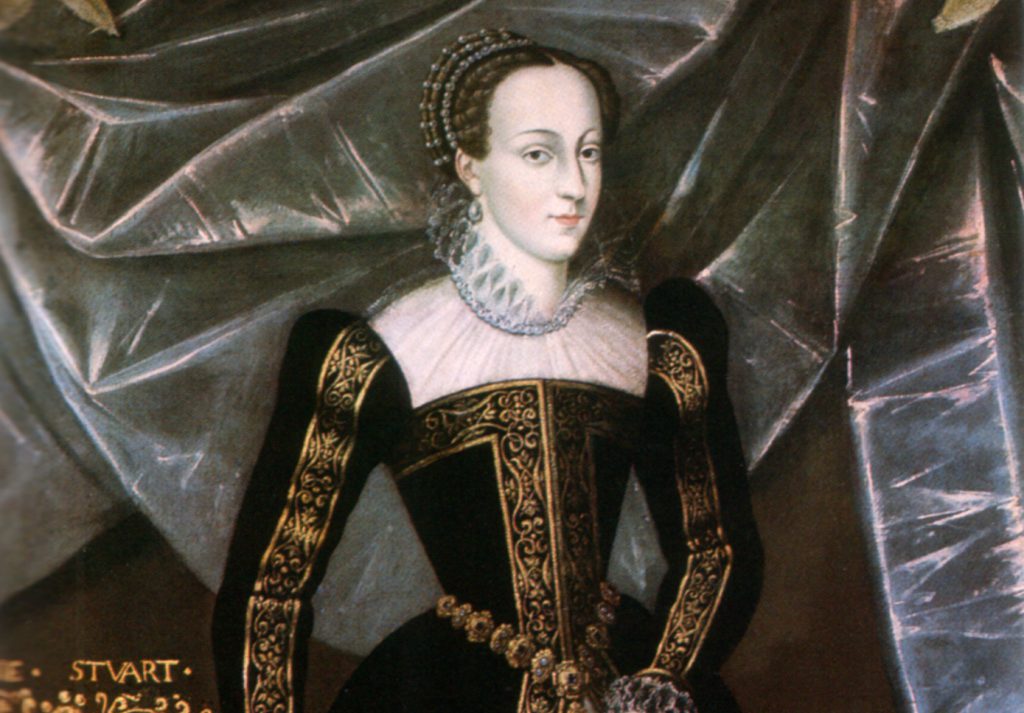Have you ever wanted something so bad you would do anything to get it? What if that goal was a crown and a whole kingdom? What would you do? Would your actions be worth it in the end if you did something that could potentially ruin your life, or even end it? Sometimes our ambitions make us act recklessly in order to achieve our goal. And in the end the results could be disastrous. As the song from the Rolling Stones says, “you can’t always get what you want,” and that is what Mary Stuart, Queen of Scotland learned the hard way when she fought for the English throne, and in the end, lost her life.
Mary Stuart was born on December 7, 1542 to King James V of Scotland and Mary of Guise1 She was the only living child of King James V, so she became the heir to the throne, and then Queen shortly after her birth, when her father died. As the granddaughter of Margaret Tudor, sister to Henry Tudor VIII King of England, she was next in line for the English throne. Because of her ties to the throne of England, she was often pushed to become the Queen of both Scotland and England.
In her attempt to become the next heir to the English throne after her cousin Elizabeth, Mary decided to wed someone who would strengthen her claim to the throne. This was a danger to Queen Elizabeth’s reign, because the people Mary considered to be a potential husband made Mary’s claim even stronger, because she would then have a husband, where Elizabeth did not. In order to gain Queen Elizabeth’s favor, Mary had considered marrying someone that Elizabeth chose for her, but when Elizabeth suggested Lord Dudley for her, the favored Earl of Leicester, Mary decided against it. Instead, she married her cousin, Henry Stuart, or Lord Darnley, who also had a claim to the English throne through his grandmother Margaret Tudor.2
This led to a rebellion in Scotland because Protestants believed that the marriage of Mary to Lord Darnley would bring Catholicism back to Scotland and England because their claim to the English throne was stronger. The rebellion was led by Mary’s half-brother James Stuart, but was defeated by Mary. This was the start of her growing unpopularity in Scotland.3 When she first met Lord Darnley, she had thought that he was charming, and quickly arranged for their marriage. But after they married, she found that his attitude was completely different. Her marriage quickly became unhappy. Lord Darnley was a drunkard and was a jealous, stubborn, immature man. Because of his immaturity, Queen Mary refused to give him the crown matrimonial, which would have allowed him to rule Scotland, and this angered him.
Mary started avoiding him, and eventually she started spending a great amount of time with some of her advisers and secretaries, particularly David Riccio. Riccio was her secretary for French correspondence, and he quickly gained influence with the Queen and her policies.4 The amount of time Queen Mary spent with Riccio created rumors that she was having an affair with the secretary and that the baby she was carrying belong to Riccio. A group confronted Lord Darnley and put this rumor in his ear. This, combined with jealousy, infuriated Lord Darnley, who created a plot to kill Riccio. In 1566, Lord Darnley, along with the group, surprised the Queen, Riccio, and a countess at dinner, and dragged Riccio out of the room and stabbed him repeatedly, killing him.5 It is also argued that Mary also could have been a target, but there is no clear evidence.
After this event Mary never forgave Lord Darnley, and their relationship became even more strained. Their son, James, who would become James I of England, was born in June 1566, and his birth did nothing to improve their relationship.6 Mary made sure that Lord Darnley would never forget what he had done, by making comments such as the ones she made when their son was born: “My Lord, God has given you and me a son, begotten by none but you. Here I protest to God as I shall answer to him… that this is your son and no other man’s son.”7 Mary would continue to push Lord Darnley away and would completely leave him out of meetings. She decided that his presence was no longer needed, and she began looking for a way to annul their marriage. Out of fear for her son’s claim to the throne, Mary was hesitant to get an annulment.

In the meantime, the Queen met and befriended another councilor, James Hepburn, the Lord Bothwell. It was also believed that the Queen was having an affair with Lord Bothwell. On February 10, 1567, Lord Darnley was killed.8 It appeared that Lord Darnley was killed when the house he was staying at had exploded, but it was later discovered that he was killed somewhere else entirely and by suffocation. Automatically, the suspicion fell on Lord Bothwell, and it is speculated that Mary also had a role in the murder.9 There is evidence that could possibly connect Mary to helping Lord Bothwell plot the death of her husband, known as the Casket Letters, but there is still not enough evidence. To this day it is still unknown whether the Queen of Scotland had a role in Lord Darnley’s murder. The rumors of an affair between Queen Mary and Lord Bothwell became stronger when she refused to convict Lord Bothwell, and he was subsequently acquitted of all charges, despite the advice of Queen Elizabeth and her former mother-in-law, Catherine Medici of France.10
Shortly after, Mary and Lord Bothwell married, which to many only confirmed the rumors. Mary claimed that Lord Bothwell abducted, raped, and forced her into the marriage.11 Like her last marriage, she was not happy. She appeared to regret marrying Lord Bothwell and seemed depressed, listless, and would often talk of suicide. Her marriage was the last straw for what little supporters she had left, and a civil war broke out in Scotland. By June, the Earl of Moray had an army to fight Queen Mary and Lord Bothwell under the banner of the murdered Lord Darnley and their son James.12 The rebels believed that Mary was no longer fit to rule because of the marriage. When she was captured at Carberry Hill, she was given the choice to keep the throne if she gave up Lord Bothwell. When she refused the offer, even her own army began to desert her. Lord Bothwell was able to escape, but the Queen was captured and taken prisoner to Edinburgh.13 On July 24, Mary was forced to abdicate the throne to her son James, and his regency would be given to the Earl of Moray.
Mary escaped Scotland to England shortly after, and begged her cousin, Queen Elizabeth, for sanctuary. Queen Elizabeth’s advisers warned her against it, because they thought she was a threat, but Queen Elizabeth allowed her to stay. While in England, Mary was under investigation again for the murder of her husband Lord Darnley, and due to the lack of evidence, she was not convicted. While in England, she was kept almost like a prisoner, under house arrest for the next eighteen years, without being able to contact her son, the now King of Scotland.14 She would spend most of her time knitting, but that was not all she was doing.

Some of Queen Elizabeth’s advisers had been keeping an eye on Mary, and they discovered three plots against Queen Elizabeth that would seal Mary’s fate. The first plot, known as the Ridolfi plot, was a conspiracy with Thomas Howard and King Philip of Spain, to assassinate Queen Elizabeth and make Mary Queen of England.15 Letters discussing the plot were intercepted by one of Queen Elizabeth’s advisers and the plot was foiled. The Queen’s advisers pushed her to punish Mary, but she refused because the evidence was not certain. In the end, Howard was executed and Mary remained a prisoner. The second plot was called the Throckmorton plot. In this the French were to invade England and assassinate Queen Elizabeth. From this, Parliament created an act for the Queen’s safety. In this act, if the Queen was killed, any party responsible would be tried and executed.16 In the final plot, Mary was caught in the act by an undercover agent who found the letters that incriminated Mary Stuart. Queen Elizabeth’s advisers strongly pushed for her to sign Mary’s death warrant, but she hesitated because she did not want the controversy of executing a queen. In the end, she reluctantly signed the warrant and on February 8, 1587, Mary was beheaded without the Queen’s knowledge.17
From the beginning, Mary Stuart had wanted the English throne and she made decisions that she thought would make her a better candidate for that throne. She thought the best way to gain the crown was through marriage, but in the end you could argue that that was the beginning of her downfall. You could say she most certainly did not get what she wanted.

- Elizabethan World Reference Library, 2007, s.v. “Stuart, Mary.” ↵
- Elizabethan World Reference Library, 2007, s.v. “Stuart, Mary. ↵
- Elizabethan World Reference Library, 2007, s.v. “Stuart, Mary.” ↵
- Women in World History: A Biographical Encyclopedia, 2002, s.v. “Mary Stuart (1542-1587),” by Kimberly Estep Spangler. ↵
- Women in World History: A Biographical Encyclopedia, 2002, s.v. “Mary Stuart (1542-1587),” by Kimberly Estep Spangler. ↵
- Women in World History: A Biographical Encyclopedia, 2002, s.v. “Mary Stuart (1542-1587),” by Kimberly Estep Spangler. ↵
- Women in World History: A Biographical Encyclopedia, 2002, s.v. “Mary Stuart (1542-1587),” by Kimberly Estep Spangler. ↵
- Encyclopedia of World Biography, 2004, s.v. “Mary Queen of Scots.” ↵
- Encyclopedia of World Biography, 2004, s.v. “Mary Queen of Scots.” ↵
- Encyclopedia of World Biography, 2004, s.v. “Mary Queen of Scots.” ↵
- Women in World History: A Biographical Encyclopedia, 2002, s.v. “Mary Stuart (1542-1587),” by Kimberly Estep Spangler. ↵
- Women in World History: A Biographical Encyclopedia, 2002, s.v. “Mary Stuart (1542-1587),” by Kimberly Estep Spangler. ↵
- Women in World History: A Biographical Encyclopedia, 2002, s.v. “Mary Stuart (1542-1587),” by Kimberly Estep Spangler. ↵
- Encyclopedia of World Biography, 2004, s.v. “Mary Queen of Scots.” ↵
- Elizabethan World Reference Library, 2007, s.v. “Stuart, Mary.” ↵
- Elizabethan World Reference Library, 2007, s.v. “Stuart, Mary.” ↵
- Elizabethan World Reference Library, 2007, s.v. “Stuart, Mary.” ↵



52 comments
Jake Mares
It is hard to believe someone who did this much wrong could be atop the power pyramid. If Mary did what she did to get to the throne, imagine what tyrannical things she may do while presiding over the kingdom. This level of greed is easily seen in the world today with many powerful people across the globe.
Julia Edwin- Jeyakumar
This is an interesting cousin rivalry story! Couldn’t stop reading it, amazing article. I always have to remind myself that cousin marriages were normal at that time. Queen Mary definitely went through a lot in her life to the point where the only control she could feel is if she was in a position of power. I’m surprised that she did it three times, she must have really hated her family. Or just went through a traumatic experience. She reminds me of the Queen of Hearts, from Alice and Wonderland cause of the pictures. The pictures showed an awesome representation of the story!
Analisa Cervantes
Mary, Queen of Scots was a very ambitious woman. She was determined to become the Queen of England no matter the cost. She did not even consider how her choices would affect her cousin, Queen Elizabeth. Especially since at the time it was believed you had the divine right to rule. Mary put Elizabeth in a difficult spot that would ultimately seal her fate.
Samantha Bonillas
The life of Mary Queen of Scots is one that, at the time, seems typical. She was given so much power at such a young age that she had to learn while ruling. Once she was in power, she wanted more of it, and what it written in the article, she married for power. Back then, women hardly married because they loved their spouse; their marriages were arranged. I watched the show “Reign” on Netflix, which was about the life of Mary Queen of Scots, which depicted her story just like this article did.
Edith Santos Sevilla
Mary Stuart had a difficult life, first her ambition for England was driving her to all of the decisions that she made. By sealing her own fate when marrying her cousin. After his murder weather being forced, or voluntary, getting married again she was never free of guilt of the murder of her husband. Her story is very interesting, how she was born into being a Queen, but because of all of the things that she lived, ambition won over her and led to her death. The conflicts that existed between Elizabeth and Mary were big, fighting for the ruling of a country, I would have thought that it would have caused her death. But at the very end Elizabeth was not directly responsable for Mary’s death. The article was interesting, and it showed good research and understanding on the topic.
Leopoldo Martinez-Milland
To be put in such a high position in such a young age would put pressure on anyone. As Hali Garcia shows us, that wouldn’t be no different for Mary Queen of Scots. However, having such power at such a young age gave Mary pressure to want more. Garcia does a good job explaining Mary’s schemes to become queen only for those same schemes leading to her downfall (i.e. her marriage and murder of her cousin, Lord Darnley). Even as a prisoner, she was still scheming of ways to become Queen of England by murdering her cousin, Queen Elizabeth. Unfortunately for the Queen of Scotland, that would lead to her beheading.
Addie Piatz
I agree that Mary was too ambitious to be queen of both England and Scotland. While I did not know that she married so many times it was interesting and also disturbing that she married her cousin to make her claim to the English throne stronger. Her ambitious and carelessness is what cost her, her head. Over all It was eye opening to learn about royal history.
D'Hannah Duran
Mary, Queen of Scots lived a tragic life from her father dying while she was young to her not being able to marry for love. When was was becoming near the perfect queen her choice for marriage made it harder than it needed to be. Then for her to remarry just for her to be unhappy is an unfortunate case for her, only in the end for her to have to give up her throne to her son when she deserved a chance to lead without having to have a husband.
Thalia Romo
It is crazy to think of the extent that some individuals would have gone in order to stay in power. Mary seems to be a manipulative person who typically gets her way, but when she doesn’t all bad things will begin. The fact that Mary decided to marry within the family is sickening, just so that she can gain more power. I’m sure that if Mary were to have acquitted Lord Bothwell, he’d been charged as guilty and she’d automatically be tied the sentencing.
Kasandra Ramirez Ferrer
Mary, Queen of Scots was a person who always had to fight harder to survive. First, she became a target the minute she was born because her father died and then had to grow up far away from her mother because she could not protect Mary from people who wanted Scotland’s throne. It is no surprise that Mary became too ambitious having such expectancy from people to take two thrones and being a woman in those times didn’t make it easy. Having to marry several men is what Mary thought was necessary so she could gain the kingdom she wanted, sadly it caused her to create many enemies along the way and ended up in being prisoner and decapitated by of the woman who she competed with for several years.